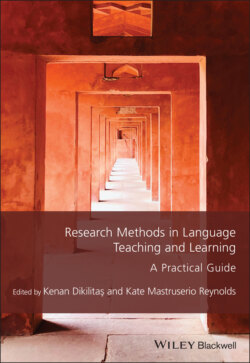Читать книгу Research Methods in Language Teaching and Learning - Группа авторов - Страница 35
Recording the Diary Data
ОглавлениеThe exact design and format of the diaries participants keep in any diary study depend on the project’s goals, the kind of data subsequently required, and the expectations, abilities, and needs of the diarists themselves; as we have seen, every study is unique (Alaszewski, 2006). In my study, therefore, the range of possible formats needed to be navigated carefully in order to balance the aims and goals of the research with the needs and priorities of the participants, all the while attending to any further practical constraints on implementing the project.
In general, more structured approaches to the timing of participants’ diary keeping require them to record their experiences at either “interval-,” “signal-,” or “event-contingent” times: interval-contingent approaches require participants to update their diaries at regular, predetermined times throughout the study; signal-contingent designs contact diarists through a messaging service (e.g., a phone call or SMS), to ask them to record their experiences at that particular time; and event-contingent studies ask participants to report each time a specific event occurs (Bolger et al., 2003). Clearly, however, many studies, including ethnographic projects, are organized in less structured ways, encouraging diarists to record those experiences which they consider to be relevant, as and when they occur. Meanwhile, although paper-and-pen approaches remain the most familiar, and provide a format which matches the socially constructed expectations of many research participants, new technologies, both offline (e.g., digital cameras and handheld audio- or video-recorders) and online (e.g., recording via SMS or online platforms) now offer a range of alternatives in project design. Such technologies may appeal to more digitally literate participants or those with limited literacy. López-Gopar’s (2014) critical ethnography of the language classes of children from marginalized social groups in Mexico, for example, drew heavily on teacher-recorded photographs and video-clips to record the realities, as teachers saw them, of classroom life. Similarly, Block’s (1996) use of audio-diaries, in which participants could choose the language they wished to record in (i.e., as multilingual language users, one of their own languages or English, which they were learning), allowed diarists more control of the research process in accordance with their own needs, preferences, and strengths. The selection of audio-, video-, and other non-traditional formats for diary recording is therefore much more than a simple adjustment to or the accommodation of participants’ literacy constraints. Rather, they offer researchers’ participants new ways of making sense of language teaching and learning.
My own study aligned with the paper-and-pen approaches that still predominate among the relatively limited number of diary-based research into language teaching and learning (e.g., Gkonou, 2012; Huang, 2005; Yi, 2008). In my project, the teacher and learners were provided with notebooks in which to record their experiences and thoughts about their lessons each day, which I read and returned on a daily basis (the project was thus broadly event-contingent, although there was some flexibility within this approach, with diarists being free to record their experiences at any time following a class but prior to their next lesson). The intention was to develop among participants a sense of “ownership” of the diaries, both as a process and as a product. More practically, collecting the diaries each day enabled the subsequent follow-up interviews to be more contemporaneous, with the classroom events being discussed, while also, I intended, maintaining and enhancing diarist participation and involvement over the course of the project (for further discussion of maintaining diarists’ participation, see below).
Paper and pen aligned with the expectations and abilities of these literate, upper-intermediate/CEFR B2 English learners and their teacher, and avoided the need for the further transcription needed with audio- or video-diaries; reporting took place in English for the practical reason that I could not myself translate the required languages, but with effects upon the data which are unclear. It may, of course, have limited the ability of some diarists to convey their experiences and perspectives as effectively as they would have liked (the project’s regular follow-up interviews with the diarists went some way in addressing this concern); alternatively, however, communication in a second or foreign language might hinder obfuscation more than it hampers articulacy, to the benefit of my research (for further discussion of the data and issues surrounding data analysis, see below). Finally, and from a somewhat mundane perspective, yet one that is important in all research projects, paper and pen was also a format that was in keeping with the study’s relatively limited budget. Undertaken before the now widespread use of smartphones, it was impossible to provide participants with the necessary number of individual audio- or video-recording devices during the research.
